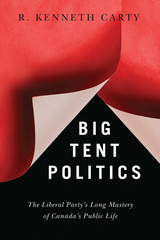
Prime Ministerial Power in Canada
Its Origins under Macdonald, Laurier, and Borden
Many Canadians lament that prime ministerial power has become too concentrated since the 1970s. Notions of “governments of one” abound, as if this is somehow a new phenomenon. This book contradicts this view by demonstrating how prime ministerial power was in fact centralized from the very beginning of Confederation and that the first three important prime ministers – Macdonald, Laurier, and Borden – channelled that centralizing impulse to adapt to the circumstances they faced.
Using a variety of innovative approaches, Patrice Dutil focuses on the managerial philosophies of each of the prime ministers as well as their rapport with senior public servants, resistance to genuine public sector reform, and use of orders-in-council to further their aims. He then compares their managerial habits during times of crisis to those during ordinary times. The research is drawn from extensive archival sources, an exhaustive survey of the secondary literature, budget documents, an examination of 20,000 orders-in-council, and a novel approach to the study of the structure of correspondence.
This is the first book to examine the administrative habits of these three prime ministers. In it, Dutil offers revealing insights into the evolution of prime ministerial power. He also shows how this centralizing grip of these early first ministers inevitably shaped the administrations they headed, as well as those that followed.
This book is for scholars and students of political science, public administration, and history as well as others interested in the centralization of power in the prime minister’s office.
Prime Ministerial Power in Canada is engaging reading. The book’s lively prose style, clarity of expression, logical and transparent structure, and meticulous attention to accuracy in detail adds to its appeal. It combines theoretical sophistication with profound historical understanding.
Prime Ministerial Power in Canada is an incredibly welcome addition to the understanding of the Canadian political executive … Any serious scholar of the Canadian political executive must read (and re-read) this book.
Dutil casts light on the minutiae of governing that elucidates the challenges of managing and entrenching power … The strength and innovation of the book is in the detailed analysis of the use of royal commissions, orders-in-council and correspondence as instruments of power.
This is a remarkable book by a distinguished author.[...]
Prime Ministerial Power in Canada is both unique and comprehensive, while adding greatly to our knowledge of the history of our country.
With this superbly-executed, comprehensive book, [St-Laurent] now gets the tribute he would not have asked for — but nonetheless deserves.
Prime Ministerial Power in Canada is a highly original – indeed path-breaking – exhaustively researched, and convincingly argued analysis with much to say to both historians and political scientists. Patrice Dutil’s fine work will be a ‘must-read’ for anyone – scholar, journalist, citizen – who wants to understand the nature of prime ministerial power in Canada, past and present.
Foreword by Robert Bothwell and John English
Introduction
1 How the Prime Ministership Was “Made”: Readings, Theories, Models
Part 1: Structure
2 Macdonald’s First Mandate: Consolidating Prime Ministerial Power
3 Macdonald Returns: Strengthening the Executive Machinery
4 Wilfrid Laurier: The Quick Apprentice
5 Robert Borden: The Inept Reformer
Part 2: Substance
6 The Public Service and the Slow Death of Patronage
7 Priority Setting and the Budget
8 The Management of Crisis
Part 3: Style
9 The Order-in-Council: A Tool of Administrative Control
10 Managing Routine: Everyday Prime Ministerial Style
Conclusion
Appendices; Notes; Index






















